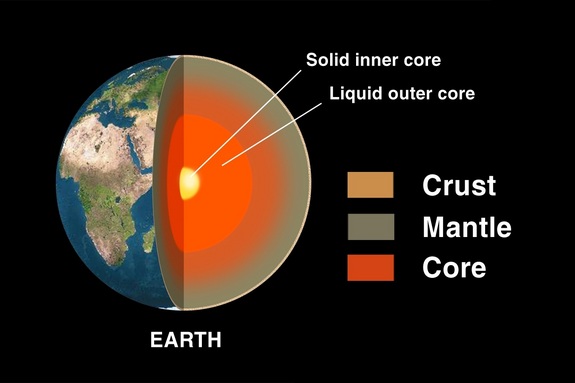
Earth's Rotating Inner Core Shifts Its Speed

Earth's solid-metal inner core is a key component of the planet, helping to give rise to the magnetic field that protects us from harmful space radiation, but its remoteness from the planet's surface means that there is much we don't know about what goes on down there. But some secrets of the inner core are being revealed by acoustic waves passing through the planet's heart and iron squeezed to enormous pressures in the lab.
Two new studies, both detailed online May 12 in the journal Nature Geoscience, reveal that Earth’s inner core may actually be softer than previously thought, and that the speed at which it spins can fluctuate over time.
Under the liquid-metal outer layer of the Earth's core is a solid ball of superhot iron and nickel alloy about 760 miles (1,220 kilometers) in diameter. Scientists recently discovered the inner core is, at 10,800 degrees Fahrenheit (6,000 degrees Celsius), as hot as the surface of the sun.
Churning in the liquid outer core results in the dynamo that generates Earth's magnetic field. Geoscientists think interactions between the inner and outer cores may help explain the nature of the planet's dynamo, the details of which remain largely unknown.
"The Earth's inner core is the most remote part of our planet, and so there is a lot we don't know about it because we can't go down and collect samples," said Arianna Gleason, a geoscientist at Stanford University in California. [Infographic: Tallest Mountain to Deepest Ocean Trench]
Shifting speeds
One way scientists can learn more about the inner core is by analyzing acoustic waves from earthquakes that ripple through the inner core as they pass through the planet. Hrvoje Tkalcic, a geophysicist at the Australian National University in Canberra, and his colleagues relied on earthquake doublets — earthquakes that occur in pairs and generate extraordinarily similar acoustic waves — to investigate the inner core. Because these waves are so alike, the data they return are readily comparable, and because they are separated relatively briefly in time, they can help the researchers image subtle changes that might occur in that time frame.
Sign up for the Live Science daily newsletter now
Get the world’s most fascinating discoveries delivered straight to your inbox.
Seismic observations and computer models of the Earth's innards suggested the inner core spins at a different rate than the mantle does, but there were conflicting estimates for how fast the inner core actually rotated. By analyzing 24 earthquake doublets, Tkalcic and his collaborators found the speed at which the inner core spun apparently fluctuated over the course of approximately decades between 1961 and 2007.
"It is the first observational evidence that the inner core rotates at a variety of speeds with respect to the mantle...It also reconciles old discrepancies," Tkalcic told OurAmazingPlanet. (Past analyses of how fast the inner core rotated came up with different speeds.)
The inner core, on average, rotates eastward. At the speeds it travels, it might, on average, complete a revolution every 750 to 1,440 years. However, these speeds appear unstable, which makes it uncertain just how long it actually takes to finish a turn on its axis, Tkalcic said.
It remains unknown exactly why these fluctuations in speed happen. Gravitational and magnetic forces likely both play a part, Tkalcic said.
Weak iron
In another study, Gleason and her colleagues sought to learn more about the inner core by mimicking its conditions in the lab. They measured the strength of iron by squeezing it within a diamond anvil at room temperature while scanning it with X-rays.
"We know the Earth's inner core is composed mostly of iron, but we don't really know too much about the behavior of iron under the pressure and temperature at conditions in the core," Gleason said.
The metal was subjected to more than 200 billion pascals of pressure, or about 180,000 times the pressure of the average human bite.
"We found the inherent mechanical strength of iron under those conditions is quite low, surprisingly weak," Gleason said.
These findings may help explain why material within Earth's inner core is apparently distributed in a lopsided way, Gleason said. The weakness of iron might lead crystallites in the inner core to flow and line up a certain way, she explained.
Gleason noted that the researchers did not mimic the extreme temperatures found in the inner core, nor did the metal they experimented with match the composition of the inner core. In future experiments, they hope to use lasers to heat the metal to the proper temperatures, and test various iron-nickel alloys.
Follow OurAmazingPlanet @OAPlanet, Facebook and Google+. Original article at LiveScience's OurAmazingPlanet.











